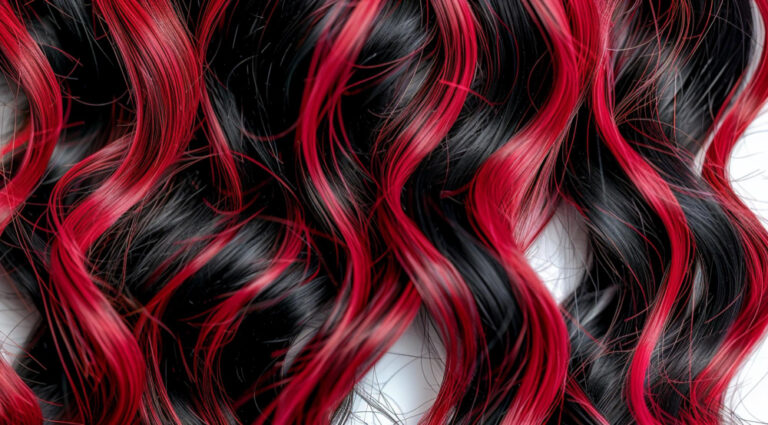Thinning hair can be a real punch to your confidence. But remember, it’s a common issue that many of us face, and there’s no shame in it. With the right tools and knowledge, you can turn this challenge into a chance to reinvent your style. So if you’re dealing with thinning hair, hair extensions could be the game-changer you’ve been searching for, but you need to do it right!
In this blog post, we’re going to guide you through the process of choosing the right hair extensions for thinning hair.
The Truth About Thinning Hair
Age is one of the biggest factors behind thinning hair. As we grow older, our hair naturally starts to thin out. This is due to changes in our hormone levels, particularly the decrease in estrogen and progesterone which are vital for hair growth and health. Moreover, conditions like alopecia areata and telogen effluvium can also lead to hair thinning. These conditions disrupt the natural hair growth cycle, causing hair to fall out faster than it can grow.
Let’s not forget about genetics. If your parents or grandparents had thinning hair, there’s a fair chance you might experience it too. It’s a genetic lottery, my friends, and some of us simply drew the short straw.
But it’s not all about what’s inside us. Environmental factors play a significant role too. Stress, poor nutrition, lack of sleep, and over-styling can all wreak havoc on our hair. These factors can lead to hair breakage, slow down hair growth, and even cause hair to fall out.
While we can’t change our age or genetics, we can certainly control our lifestyle and hair care practices. Plus, remember our best ally? Hair extensions! They’re a fantastic way to add volume and length, while you work on improving your hair health.
Strategies for Managing Hair Loss
While hair extensions are a fantastic tool for boosting volume and length, they’re not a standalone solution. To effectively manage hair thinning, we need a multi-pronged approach.
What you put into your body directly impacts what you see on the outside. For healthy hair growth, you need to fuel up on the right nutrients. Incorporate foods rich in iron, zinc, vitamins A, C, D, and E, and proteins into your diet. These nutrients help to strengthen hair follicles and promote hair growth.
Next, hydration is key. Just as your body needs water to function, your hair needs it to stay strong and healthy. So, make sure you’re drinking plenty of water throughout the day.
Moving on, consider scalp treatments. A healthy scalp is the foundation of healthy hair. Regularly massaging your scalp can stimulate blood circulation, promoting hair growth. You could even go a step further and use essential oils like lavender, rosemary, or peppermint, which are known to boost hair health.
Additionally, it’s crucial to minimize heat and chemical damage. Overuse of heat styling tools and harsh chemical treatments can weaken your hair, leading to breakage and thinning. Try to limit their use and opt for natural styling methods whenever possible.
And lastly, don’t underestimate the power of a good night’s sleep. During sleep, your body goes into repair mode, fixing any damage done during the day, including hair damage. So, ensure you’re getting a solid 7-9 hours of sleep each night.
Remember, everyone’s hair is unique, so what works for one might not work for another. It’s all about finding what works best for you and your hair.
If you’re reluctant to try hair extensions, try these hairstyles for thinning hair.
The Best Hair Extensions for Thinning Hair
When it comes to thinning hair, not all extensions are created equal. Some are simply better suited for fine or thinning hair. So let’s break down the best options available, focusing on weight and attachment methods.
Volume Weft Extensions
Ideal for adding thickness and fullness, volume weft extensions consist of multiple strands of hair sewn together at the top (the weft) to create a dense and voluminous look. Made from either human hair or synthetic fibers, these extensions offer a natural appearance and feel.
They can be applied by sewing, gluing, or using clips at the root, allowing for a fuller hairstyle that can be styled as natural hair, including washing, curling, and straightening. The method of application and maintenance may vary, but they generally provide a significant boost in volume and can last from several weeks to a few months with proper care.
Tape-In Extensions
Lightweight and discreet, these are an ideal choice for thinning hair. They involve a method where wefts of hair are attached to your natural hair using a sticky, adhesive strip. Because they distribute weight evenly across your hair, they’re less likely to cause any damage or stress. Plus, they blend seamlessly with your natural hair, making them a great choice for a natural, fuller look.
Microbead Extensions
These involve attaching tiny wefts of hair to small sections of your natural hair using a metal bead. They’re lightweight and adjustable, making them ideal for thinning hair. However, they require a professional touch for installation and maintenance, so keep that in mind.
Clip-In Extensions
These are perhaps the most user-friendly options. They come with clips attached that you simply clip into your hair. They’re easy to apply and remove, and you can do it all from the comfort of your home. However, it’s essential to ensure the clips are not too tight as they can pull and damage thinning hair.
Halo Extensions
These are a no-damage solution for thinning hair. A halo extension is a weft of hair attached to a wire that sits on your head like a halo (hence the name), with your own hair pulled through and over the wire. They’re completely weightless and require no clips, glue, or tape.
Each of these extensions has its pros and cons, and the best one for you depends on your specific needs, lifestyle, and budget. If you are looking to get hair extensions in Ridgewood, make sure to visit Artists and Architects Salon. Also if you are new to Keratine treatments, you can also swing by.
Guide to Choosing Your Perfect Hair Extension Type
Choosing the perfect hair extensions for your thinning hair isn’t just about picking the most popular type or the one your favorite celebrity uses. It’s about finding the one that fits you—your hair, lifestyle, and personal preferences. Here are some key factors to consider:
- Texture Match: This is a biggie. Your extensions need to blend seamlessly with your natural hair, and that’s where texture comes into play. Whether your hair is straight, wavy, curly, or coily, make sure to choose extensions that match. Not only will this make your extensions look natural, but it also means less styling and manipulation, reducing potential damage to your hair.
- Hair Health: Remember, your hair’s health is paramount. If your hair is significantly thinning or damaged, opt for non-damaging options like halo extensions that don’t attach directly to your hair. If you have healthier thin hair, you could consider options like tape-ins or micro-links, which can add significant volume without causing damage if installed correctly.
- Lifestyle Needs: Think about your day-to-day life. If you’re always on the go, you might want to opt for something low-maintenance like clip-ins or halo extensions. If you don’t mind a bit of upkeep and want something more permanent, tape-ins or micro-links might be your best bet.
- Professional Advice: Lastly, don’t underestimate the value of professional advice. A good hairstylist can assess the condition of your hair, consider your lifestyle and preferences, and recommend the best type of extensions for you.
What Hair Extensions to Avoid
Just as there are extensions that can work wonders for your hair, there are also those that might not be the best fit. Here’s the lowdown on the types to steer clear of:
- Heavy Extensions: If you’re dealing with thinning hair, heavy extensions are a big no-no. They can put stress on your hair follicles, leading to further hair loss. This means extensions like sew-in wefts or certain types of clip-ins might not be your best bet.
- Glue-In Extensions: These types of extensions involve using glue to attach the extension to your hair. While they might offer a secure fit, the glue can cause damage when removing the extensions. It can pull on your hair, leading to breakage.
- Poor Quality Extensions: Cheap, synthetic extensions might be tempting, but they can cause more harm than good. They often don’t blend well with your natural hair and can cause tangles, leading to breakage. Instead, invest in high-quality, human hair extensions that are gentle on your hair and look natural.
- Extensions That Don’t Match: Extensions that don’t match your hair texture or color can lead to over-styling as you try to make them blend. This can cause further damage to your thinning hair.
Final Thoughts
Hair extensions can be a game-changer, adding volume and length to your hair. But it’s essential to choose the right ones to avoid further damage. Prioritize lightweight, high-quality extensions that match your hair’s texture and color.








